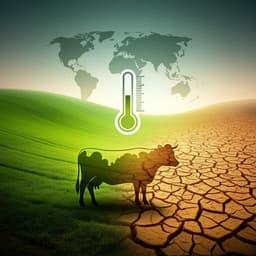
Earth Sciences
Strengthened impact of boreal winter North Pacific Oscillation on ENSO development in warming climate
S. Chen, W. Chen, et al.
Discover how the North Pacific Oscillation (NPO) enhances the El Niño-Southern Oscillation (ENSO) development amidst greenhouse warming. This compelling research by Shangfeng Chen, Wen Chen, Shang-Ping Xie, Bin Yu, Renguang Wu, Zhibiao Wang, Xiaoqing Lan, and Hans-F Graf reveals the strengthened wind-evaporation-SST feedback that holds promise for improving long-lead ENSO predictions.
~3 min • Beginner • English
Introduction
ENSO exerts widespread impacts on global climate, ecosystems, and society and is a key source of seasonal predictability. Beyond tropical processes, extratropical atmosphere–ocean variability, especially the boreal winter North Pacific Oscillation (NPO), can precondition and trigger ENSO via the seasonal footprinting mechanism: NPO-induced subtropical SST anomalies propagate equatorward and modulate equatorial winds through the wind–evaporation–SST (WES) feedback, influencing ENSO evolution in the following winter. Observations indicate many winter NPO events precede ENSO events, and shifts since the early 1990s have linked stronger NPO impacts to increased central Pacific El Niños. The study addresses the unresolved question of how greenhouse warming alters the influence of winter NPO on subsequent ENSO development.
Literature Review
Prior work established the NPO as a key extratropical mode affecting ENSO via the seasonal footprinting mechanism (Vimont et al. 2001, 2003) and its linkage to Pacific Meridional Mode (PMM) variability that influences ENSO growth (Chang et al. 2007; Amaya 2019). Observations have highlighted strong El Niño/La Niña events following winter NPO phases and a post-1990 increase in central Pacific El Niños tied to extratropical forcing (Yu et al. 2011; Yeh et al. 2015). Mechanisms proposed include WES feedback, trade-wind charging of equatorial heat content, and upper-tropospheric pathways modulating low-level tropical winds. Under warming, several studies suggest intensified thermodynamic coupling and altered extratropical–tropical linkages, including potential strengthening of PMM impacts on ENSO (Jia et al. 2021; Fan et al. 2022). However, a systematic assessment of how greenhouse warming modifies the winter NPO’s impact on ENSO had remained lacking.
Methodology
- Data: Observational/reanalysis datasets include NCEP/NCAR reanalysis (SLP, winds, precipitation, momentum fluxes; 2.5° grids/T62 surface) from 1948-present, and NOAA ERSSTv5 SST (2.5° grids) from 1854-present. Observational series are quadratically detrended over 1949–2021.
- CMIP6 models: 37 models (one member each), historical forcing to 2014 and SSP5-8.5 through 2100. All data regridded to 2°×2°, monthly anomalies formed relative to 1900–2099 climatology, then quadratically detrended over 1900–2100.
- Periods: Present-day climate period 1900–1990 and future climate period 2007–2097 (each 91 years) to reduce internal variability.
- NPO index: A common basis function approach is used. The observed winter (D−1JF0) NPO pattern is defined as EOF2 of quadratically detrended SLP over 20°–70°N, 120°E–100°W (1949–2021). Model winter SLP anomalies are projected onto the observed EOF2 to obtain model NPO indices. Indices are standardized over each analysis period. Regression of SLP onto the normalized NPO index yields spatial patterns.
- ENSO metric: Boreal winter Niño3.4 SST index (5°S–5°N, 120°–170°W). To isolate NPO impacts, concurrent D−1JF0 ENSO signals are linearly removed where noted.
- Model selection: Models are evaluated for reproducing the winter NPO–following winter ENSO link via correlation between D−1JF0 NPO and D0JF1 Niño3.4 (after removing D−1JF0 ENSO). Twenty-nine models with significant correlations are used for main analyses; results across all 37 models are also assessed.
- Responses: For each period, OND0JF1 SST and precipitation responses to D−1JF0 NPO are computed by regressing quadratically detrended anomalies onto the normalized NPO index. TCEP region: 5°S–5°N, 160°E–90°W. Wind responses (850 hPa and surface) and patterns are analyzed seasonally.
- Event definition: NPO events are winters with |D−1JF0 NPO| ≥ 1.0 s.d.; ENSO events are OND0JF1 Niño3.4 with |index| ≥ 1.0 s.d. Thresholds are period-specific to account for amplitude changes. Strong ENSO uses 1.5 s.d.
- WES feedback: Intensity characterized by the WES parameter (sensitivity of surface latent heat flux to wind changes) over the subtropical North Pacific (5°–25°N, 160°E–130°W) in MAMJJA0, following previous formulations. Contributions from mean wind speed vs background SST changes are examined; mean winds change little, while mean SST rises.
- Mechanism tests: Assess changes in trade wind charging using surface wind stress curl (2.5°–12.5°N, 120°–180°W) and in upper-tropospheric (200 hPa) zonal winds associated with NPO. Neither shows substantial change explaining the strengthened impact.
- Atmospheric model experiments: CAM5 sensitivity runs include a control with climatological SST (EXPctrl), a perturbation with imposed spring–summer subtropical North Pacific NPO-related SST anomalies (EXPsnpsst), and a perturbation with the same anomalies plus added background tropical/subtropical SST warming (EXPsnpsst&bgsst). Last 28 years analyzed; differences in JJA0 low-level winds over the tropical western–central Pacific quantify the role of background SST warming.
- Large ensembles: 100-member MPI-ESM (1950–2100; historical then RCP8.5) and 50-member CanESM2 ensembles (1950–2100) used to evaluate robustness. Changes compared between 1950–2004 and 2043–2097 for MPI-ESM.
- Statistics: Bootstrap tests (10,000 resamples) assess significance of changes in responses and occurrence ratios between periods. Pattern correlations and multi-model/ensemble means used to summarize results.
Key Findings
- Strengthened ENSO response to winter NPO under warming:
- In 29 selected CMIP6 models, the TCEP OND0JF1 SST response increases by 32% (MME from 0.25 °C to 0.33 °C); significant at 95% (bootstrap). Across all 37 models, increase is 41% (0.22 to 0.31 °C s.d.).
- Tropical precipitation response in TCEP increases by 65% (MME from 0.37 to 0.61 mm day−1 s.d.). Patterns show stronger OND0JF1 SST warming and surface westerlies in the TCEP under warming.
- Increased likelihood that winter NPO is followed by ENSO:
- Positive NPO followed by El Niño occurrence ratio rises from 0.27 to 0.33 (+22%), significant.
- Negative NPO followed by La Niña rises from 0.27 to 0.34 (+26%), significant.
- Strong events (|Niño3.4| ≥ 1.5 s.d.): positive NPO → strong El Niño increases by 39%; negative NPO → strong La Niña increases by 22% (aggregated across models).
- Despite MME increases, ~33% (positive→El Niño) and ~20% (negative→La Niña) of models show decreases, reflecting other influences on ENSO.
- Mechanism: Enhanced subtropical WES feedback due to warmer background SST strengthens NPO-triggered equatorial wind anomalies.
- All 29 models show increased MAMJJA0 WES feedback over the subtropical North Pacific. Mean surface wind speed changes are weak and cannot explain the increase; nonlinear SST–evaporation relation with higher mean SST is implicated.
- Stronger JJA0 surface westerly anomalies over the tropical western–central Pacific in response to the same subtropical SST anomalies.
- CAM5 experiments confirm that adding background tropical/subtropical SST warming substantially amplifies JJA0 low-level westerly responses to identical subtropical SST perturbations.
- Little change is found in NPO-related trade wind charging (wind stress curl) or in upper-tropospheric easterly anomalies over the equatorial Pacific; changes in NPO amplitude or its southern lobe intensity do not explain the strengthened coupling.
- Robustness in large ensembles:
- MPI-ESM 100-member ensemble shows increased winter NPO–following winter Niño3.4 correlation and strengthened ONDJDJF1 TCEP SST response in most members (68%), with significant MME increase; WES feedback and JJA0 TWCP zonal wind responses also strengthen.
- CanESM2 50-member ensemble similarly shows significantly larger NPO–ENSO correlation in the future period.
- Link to PMM: The response of spring subtropical North Pacific SST (a PMM metric) to winter NPO is significantly enhanced, and inter-model changes in PMM response covary with changes in the subsequent ENSO response.
Discussion
The study directly addresses whether the boreal winter NPO will exert a stronger influence on subsequent ENSO under greenhouse warming. Across CMIP6 models and two large-ensemble frameworks, warming leads to larger tropical Pacific SST, precipitation, and wind responses to a unit winter NPO forcing. Mechanistically, warmer mean SST enhances the WES feedback in the subtropical North Pacific, producing stronger summer westerly anomalies over the tropical western–central Pacific, which in turn more effectively trigger ENSO via Bjerknes feedback. Alternative pathways (trade wind charging, upper-tropospheric modulation) and changes in NPO amplitude do not account for the strengthened coupling. The enhanced NPO–ENSO linkage increases the frequency of NPO events followed by ENSO, including strong events, implying improved potential predictability at longer lead times when forecasts are initialized in boreal winter. The strengthened connection also appears partly mediated by enhanced NPO impacts on the spring PMM, consistent with a tighter extratropical–tropical coupling in a warmer climate.
Conclusion
Greenhouse warming strengthens the impact of boreal winter NPO on the following winter ENSO. This arises primarily from an enhanced subtropical WES feedback under higher background SST, which amplifies NPO-forced equatorial westerlies and subsequent ENSO development. The effect is robust across CMIP6 models and large-ensemble simulations (MPI-ESM, CanESM2) and manifests as larger tropical Pacific SST/precipitation responses and increased frequency of NPO events followed by ENSO, including strong events. These results suggest that as warming continues, the NPO will become a more influential driver of ENSO, potentially enhancing predictability when forecasts are initialized in boreal winter. Future work could examine contributions from other extratropical modes and quantify scenario dependence, model uncertainties, and observational constraints to refine predictions.
Limitations
- Model diversity: Although multi-model means show increases, about 33% (positive NPO→El Niño) and 20% (negative NPO→La Niña) of models exhibit decreases in occurrence ratios, indicating sensitivity to other processes and model differences.
- Mechanistic scope: Trade wind charging and upper-tropospheric pathways show limited change, but other extratropical influences beyond the NPO can affect ENSO, complicating attribution.
- Event thresholds and period choices: Results depend on standardized thresholds and specific present/future periods; alternative definitions may yield quantitative differences.
- Emissions scenario and model dependence: Analyses emphasize high-emission scenarios (SSP5-8.5/RCP8.5) and specific model ensembles; generalizability across scenarios and models warrants further evaluation.
- Internal variability: Despite long periods and large ensembles, internal variability can still influence estimated changes in coupling strength.
Related Publications
Explore these studies to deepen your understanding of the subject.







